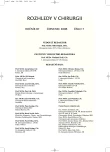Hybrid Procedures in the Treatment of Pseudoaneurysms of the Aortic Arch – Case Report
Authors:
V. Kuntscher 1; V. Třeška 1; M. Novák 2; F. Šlauf 2; B. Bohuslav 1; J. Křižan 1; R. Šulc 1; J. Moláček 1
Authors‘ workplace:
Surgical Clinic, University Hospital Plzeň-Lochotín, Head of Dept. : Prof. MUDr. V. Třeška, DrSc.
1; Radiodiagnostic Clinic, University Hospital Plzeň, Head of Dept. : Assoc. Prof. MUDr. B. Kreuzberg, Ph. D.
Medical Faculty in Plzeň, Charles University in Prague
2
Published in:
Rozhl. Chir., 2008, roč. 87, č. 7, s. 384-387.
Category:
Monothematic special - Original
Overview
Classical surgical therapy of dilatation disorders of the aortic arch require extracorporeal circulation, selective brain perfusion and/or deep hypothermia and it is still associated with very high mortality and morbidity. Endovascular therapy has until recently indicated only been in cases when the disease did not affect the area of the origins of the main branches within the aortic arch. We are presenting a case report of a 68 year female patient with a vascular anomaly (arteria lusoria) and 2 pseudoaneurysms of the aortic arch between the origins of arteria carotis communis on the right and arteria carotis communis on the left, respectively between a. carotis communis on the left and arteria subclavia on the left, when we took advantage of a hybrid procedure in the therapy. The patient was treated by creating a new branching of the aortal arch using a prosthesis from the ascendant aorta and subsequently by an introduction of 2 stent-grafts to the aortic arch using femoral arteries.
Key words:
aortic arch – aneurysm – hybrid therapy – stent-graft
Sources
1. Kazui, T., Washiyama, N., Muhammad, B. A., Terada, H., Yamashita, K., Takinami, M., Tamiya, Y. Total arch replacement using aortic arch branched grafts with the aid of antegrade selective cerebral perfusion. Ann. Thorac. Surg., 70 (2000) (1), pp. 3–8.
2. Gottardi, R., Lammer, J., Grimm, M., Czerny, M. Entire rerouting of the supraaortic branches for endovascular stent-graft placement of an aortic arch aneurysm. Eur. J. Cardiothorac. Surg., 29 (2006), pp. 258–260.
3. Fiřt, P., Hejnal, J., Vaněk, I. Výduť aortalního oblouku. In: Cévní chirurgie. Avicenum, 1991, pp. 303–306.
4. Czerny, M., Baumer, H., Kilo, J., Lassnigg, A., Hamwi, A., Vukovich, T., Wolner, E., Grimm, M. Inflammatory response and myocardial injury following coronary artery bypass grafting with or without cardiopulmonary bypass. Eur. J. Cardiothorac. Surg., 17 (2000) (6), pp. 737–742.
5. Czerny, M., Fleck, T., Zimpfer, D., Dworschak, M., Hofmann, W., Hutschala, D., Dunkler, D., Ehrlich, M., Wolner, E., Grabenwoger, M. Risk factors of mortality and permanent neurologic injury in patients undergoing ascending aortic and arch repair. J. Thorac. Cardiovasc. Surg., 26 (2003) (5).
6. Dotter, C. T. Transluminally-placed coilspring and endarterial tube grafts: long term patency in canine popliteal artery. Invest. Radiol., (1969) (5), pp. 329–332.
7. Balko, A., Piasecky, G. J., Shah, D. M., Carney, W. I., Hopkins, R. W., Jackson, B. T. Transfemoral placement of intraluminal polyuretane prosthesis for abdominal aortic aneurysm. J. Surg. Res., (1986) (4), pp. 305–309.
8. Pavcnik, D., Ferko, A., Krajina, A. Endovaskulární výkony na hrudní aortě. In: A. Ferko, A. Krajina: Arteriální aneuryzmata. ATD, 1999, pp. 53–63.
9. Brunkwall, J., Gawenda, M., Sudkamp, M., Zahringer, M. Current indication for endovascular treatment of thoracic aneurysms. J. Cardiovasc. Surg. (Torino), 44 (2003), (3), pp. 465–470.
10. Sunder-Plassmann, L., Orend, K. H. Stentgrafting of the thoracic aorta – complications. J. Cardiovasc. Surg. (Torino) 46, (2005) (2), pp. 121–130.
Labels
Surgery Orthopaedics Trauma surgeryArticle was published in
Perspectives in Surgery

2008 Issue 7
Most read in this issue
- Pectoralis Maior Tendon Rupture and Anabolic Steroids in Anamnesis – a Case Review
- Re-expansion Pulmonary Edema as a Complication of a Spontaneous Pneumothorax Drainage – a Case Review
- Rare Cases of Extensive Retroperitoneal Liposarcomas
- Stents – Paliative and Curative Management of Esophageal Conditions. Seven-Year Surgical Experience
